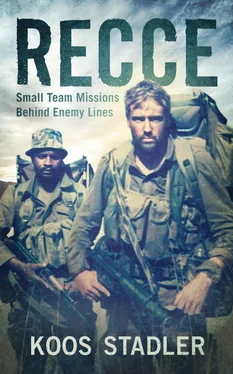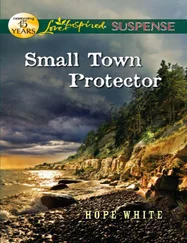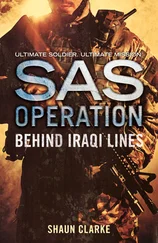A day before the deployment, all the groupings were mustered for an initial Int and Ops briefing. The final briefing for the attack would be given at the forward base – after the reconnaissance. A massive sand model had been built under a double tent canopy. Major Dave Drew, the intelligence officer for the deployment, presented the general intelligence picture. Then he designated Captain Robbie Blake, at the time the intelligence officer for 51 Commando at Ondangwa, who had done a detailed target study of the Eastern Front HQ, to present the target briefing. The whole of 5 Recce, reinforced by a company from 101 Battalion and elements from 2 Recce, the Reserve Force element of Special Forces, gathered around the model.
The grouping leading the main attack consisted of Major Duncan Rykaart’s 52 Commando – supported by the company from 101 Battalion as well as elements from 2 Recce. Major Niek du Toit and 53 Commando would be deployed as stoppers to the north of the base, while Major Buks Buys would lead 51 Commando to an escape route west of the target. A mortar platoon would deliver indirect fire support. Da Costa and I, the two Small Team operators who would do the reconnaissance, filled the last positions around the sand model.
The Eastern Front HQ was a typical guerrilla base, with an estimated strength of between 270 and 350, depending on the movement of its detachments. The defence of the camp was based on two 82-mm mortars, three 60-mm mortars, three DShK 12.7-mm anti-air machine guns that could be deployed in the ground role, and a number of SA-7 shoulder-launched missiles. Early-warning posts were deployed four kilometres to the east and south of the base.
It had been gleaned from radio intercepts, direction-finding and SWAPO prisoners of war that the base was situated next to a southward-flowing river, with a vehicle track passing east–west through the base. However, the recce team would have to pinpoint the position, determine a location for the forming-up point, decide on the direction of attack, and allocate positions for the mortar platoon as well as the cut-off groups. A tall order, I thought, considering we had only six days for infiltration, reconnaissance and exfiltration.
FAPLA’s 35 Brigade was positioned at Techamutete, about 60 km northwest of the target, while tactical groups were stationed at Cassinga and Cuvelai to the west and southwest. A Cuban regiment was based at Jamba to the north (not the Jamba that served as Jonas Savimbi’s headquarters). Fighter aircraft were operating from Menongue, a mere 80 km northeast of our target.
Colonel Hills presented the Ops briefing himself. The columns of vehicles would depart from Oshivelo in the early morning hours of 3 November. By first light the convoys would be south of the border west of the Cubango River, in order to cross that night. The logistics echelon, under RSM Koos Moorcroft, would follow the next night. The whole force would regroup north of the border and head along an established UNITA route to the forward base approximately 60 km east of the target area. From there the recce team would be deployed, while the attack force would remain in position until they returned.
When I caught Da Costa’s eye, his faced was pulled into a grimace. I knew what he was thinking: it went against all principles to do a reconnaissance against time, especially where the success of the attack depended entirely on what the recce team reported. Moreover, we both understood that if the team was compromised it would mean certain failure, as the attack would have to be called off, or – worse – that the enemy could be ready and waiting for the attack force.
When I told Colonel Hills after the briefing that there was not enough time for a proper reconnaissance, and that we should have deployed earlier, he just said, “Vasbyt, Kosie, ek weet julle kan [Hang in there, Kosie, I know you can].” As a sign of affection, he used to call me by the diminutive form of my name, but at that moment I was in no mood to appreciate it.
“But what if we don’t find the base? I mean, if it’s not there and we need more time?” I persisted, because I knew every step we made would be scrutinised by everyone in the unit. I sure wasn’t ready for failure.
He cut me short. “The base is there and you’ll find it.”
End of story. Hills was confident that the intelligence was accurate and that the “A-Team”, as he used to call us, would be successful.
“If you are compromised or you don’t find the base in six days, we’ll move in with the whole force. Then it becomes an area operation,” he said, but it was little consolation to the team. To us it was crucial that the base was located, but time was not on our side.
During our long vehicle infiltration, Da Costa and I drove in the command group, sharing a Casspir with one of the two unit chaplains, Padre Thinus Riekert, as well as some of the intelligence staff. Thinus was a deeply religious man but also an enlightened individual. We had many long, interesting conversations on the road and came close to solving the world’s problems with our infinite wisdom and insight.
After four days of travelling, the whole force arrived at the UNITA forward base from where both the reconnaissance and the attack would be launched. The UNITA base commander was clearly not happy with the large force moving into his territory, as it could compromise the position of his base – especially considering that it was within 80 km of Menongue airfield, where FAPLA had a squadron of MiG-21s. But he must have received instructions to accommodate us, and to this end did his best to please the South Africans.
Da Costa and I didn’t waste any time. We made a final comms check, packed our kit on one of the Unimogs and said our goodbyes. I drove with the team leader on the first vehicle and navigated on a bearing straight towards the target area. After 20 km we stopped. It was just short of last light. So far we hadn’t seen any tracks. We got off and the vehicles immediately turned around and left on their tracks. We moved into the undergrowth and waited for our eyes to adjust to the coming darkness. The noise of the Unimogs died away and all was quiet.
The moon was up and we decided to make good use of the available light, knowing that we were still far from the target. We covered a good fifteen kilometres, applying anti-tracking and movement techniques as much as the relatively fast pace allowed. When the moon set, at 02:00, we got a few hours’ sleep but dawn found us on the move again.
With the sun behind us, we decided to steal a few hours of daylight. We still hadn’t found any spoor and the bush was untouched. By mid-morning we decided not to push our luck and went into a hide. We settled into a routine of listening and watching. In the late afternoon we were rewarded with the first sign of the enemy – a series of explosions far to the west. I took a bearing and logged it, roughly drawing the direction on the map.
Again we decided to use some daylight, but this time we had the late-afternoon sun against us. As this was very dangerous, we decided to wait until the sun had set behind the tree line. Nevertheless, we made good time and went well into the night by the bright and beautiful moon. Early the next morning we were up and moving. We soon found some old SWAPO tracks, probably from a hunting party, and decided to don our anti-track bootees. By mid-morning we were in a hide again.
Before long we again heard continuous explosions. “Mortar practice…” Da Costa whispered.
Again I took the bearings and logged them on the map. As long as the enemy was there, we’d certainly find them.
In the heat of the day I crawled over to Da Costa to discuss our approach. The plan was to move at an angle towards the target area, logging the sound of explosions as we approached. We would keep moving until we had passed the suspect area. Only once we had a reasonable grasp of the base’s location would we turn and start moving towards it. We would start the final approach only as soon as we knew the exact location. I tried not to think of a penetration yet. That was the dangerous part – and hopefully would not be necessary.
Читать дальше












